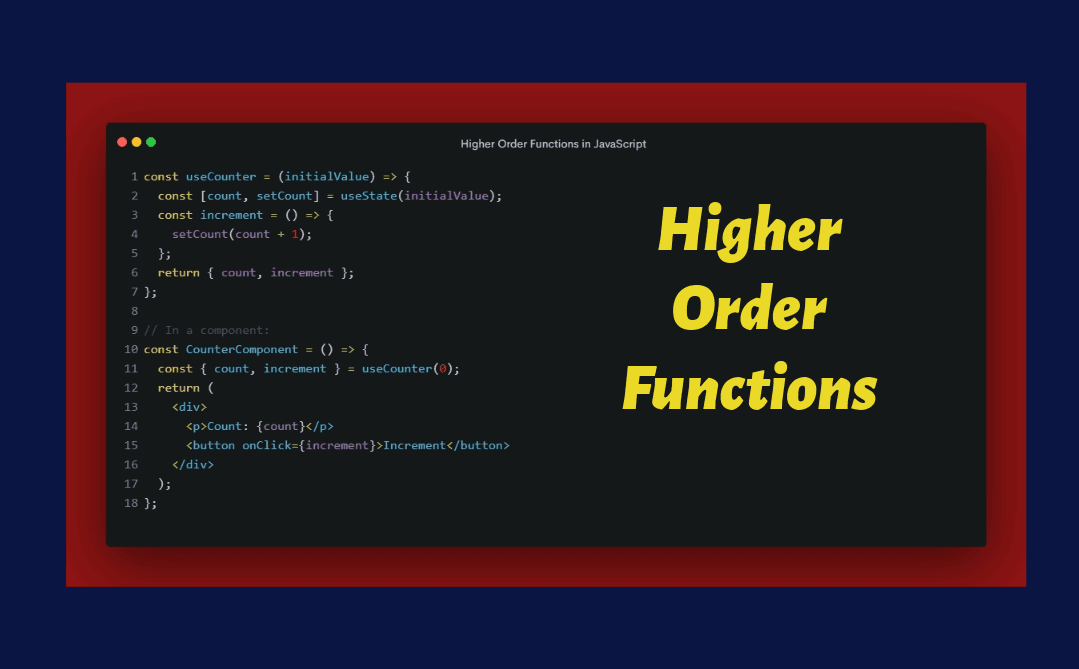If you've been working with JavaScript in the realms of React, Node.js, or any other project, you've likely come across the term "Higher-Order Functions" (HOFs). They're a powerful concept that can help you write cleaner, more modular, and reusable code. In this blog post, we'll break down what Higher-Order Functions are and explore various use cases for them.
What Are Higher-Order Functions?
Higher-Order Functions, or HOFs for short, are functions in JavaScript that can do one or both of the following:
- Take other functions as arguments.
- Return functions as their results.
In simpler terms, think of HOFs as functions that work with other functions. They are versatile tools that allow you to abstract and encapsulate behavior, making your code more flexible and maintainable.
Now, let's dive into practical use cases for Higher-Order Functions, along with code samples on how to use them.
1. Creating Reusable React Components
In React, Higher-Order Components (HOCs) are a classic example of HOFs. They take a component as input and return a new component with enhanced functionality. Here's an example:
const withLogger = (WrappedComponent) => {
return function WithLogging(props) {
console.log(`Rendering: ${WrappedComponent.name}`);
return <WrappedComponent {...props} />;
};
};
const BetterComponent = withLogger(MyComponent);
In this example, withLogger is a Higher-Order Function that adds logging capabilities to any React component, allowing you to use BetterComponent in your application.
2. Creating Reusable React Hooks
React custom hooks are another way to leverage Higher-Order Functions. Create custom hooks that abstract common behavior and reuse them across components. Here's a simple example of how to use a custom hook:
const useCounter = (initialValue) => {
const [count, setCount] = useState(initialValue);
const increment = () => {
setCount(count + 1);
};
return { count, increment };
};
// In a component:
const CounterComponent = () => {
const { count, increment } = useCounter(0);
return (
<div>
<p>Count: {count}</p>
<button onClick={increment}>Increment</button>
</div>
);
};
3. Creating API Calls with Token
When working with APIs, you can use HOFs to create a function that handles authentication and token management. Here's how to use a Higher-Order Function for making authenticated API calls:
const withAuthToken = (apiFunction, authToken) => {
return async (url, data) => {
const headers = {
Authorization: `Bearer ${authToken}`,
};
return await apiFunction(url, data, headers);
};
};
// To use the withAuthToken function:
const authenticatedApiCall = withAuthToken(apiCallFunction, 'yourAuthToken');
// Now, you can use authenticatedApiCall to make API requests with authentication.
4. Creating Testable Components
Higher-Order Functions can make your components more testable. You can create a HOF that abstracts side effects or dependencies, allowing you to easily mock or replace them during testing. Here's how to use such a function:
const withApiService = (Component, apiService) => {
return function WithApiService(props) {
return <Component {...props} apiService={apiService} />;
};
};
// In your component:
const MyComponent = ({ apiService }) => {
// Use apiService to make API requests.
// ...
};
const TestableComponent = withApiService(MyComponent, mockedApiService);
// Now, you can use TestableComponent for testing with the mocked API service.
5. Creating Reusable Error Handler/Functions in Node.js
You can also use Higher Order Functions in Nodejs. For example, you can create HOFs that manage error handling or middleware functions in an Express.js application. Here's how to use such a function:
const errorHandler = (handler) => {
return async (req, res, next) => {
try {
await handler(req, res);
} catch (error) {
// Handle and log the error
next(error);
}
};
};
// In your Express.js routes:
app.get('/myRoute', errorHandler(async (req, res) => {
// Your route logic here. No need to handle errors anymore here.
}));
In conclusion, Higher-Order Functions are a fundamental concept in JavaScript that can greatly enhance code reusability, modularity, and maintainability. Whether you're working with React, Node.js, or any other JavaScript project, I believe understanding and effectively using HOFs can make your code more powerful and maintainable. So go ahead, leverage the power of Higher-Order Functions in your projects and write cleaner, more efficient code.



